Family Gruidae (Cranes)
There are 15 living species of cranes in four genera. Though there are not many birds in this family, they are widespread in wetland and grassland habitats worldwide, though they are conspicuously missing from both Antarctica and South America. The greatest diversity of crane species is found in Asia and Africa, and these birds have been popular in cultural symbolism for centuries, including in Greek, Roman, Asian and Native American legends and mythologies. Unfortunately, more than two-thirds of crane species are considered vulnerable, threatened or endangered.
Though there is considerable variation among the crane species in terms of color and feathers, with many species having notable plumes, characteristics that Gruidae birds share include:
Tall size, with long, thin legs and necks
The long neck is held out straight in flight
Relatively dull, monochromatic plumage, but may have brighter skin or feathering on the head
Monogamous mating after elaborate courtship dances, with pairs often mating for life.
Cranes are highly vocal and have a large vocabulary of specialized calls. The cranes' duett calls are most impressive. They can be used for individual recognition.
Links:
International Crane Foundation
EWT Cranes
Africa Wild Bird Book
Family Gruidae (Cranes) Index
Species indigenous to southern Africa:
Family Gruidae (Cranes)
Balearica regulorum Grey Crowned Crane 209
Grus paradisea Blue Crane 208
Grus carunculatus Wattled Crane 207
Family Gruidae (Cranes)
Balearica regulorum Grey Crowned Crane 209
Grus paradisea Blue Crane 208
Grus carunculatus Wattled Crane 207
- Flutterby
- Posts: 44029
- Joined: Sat May 19, 2012 12:28 pm
- Country: South Africa
- Location: Gauteng, South Africa
- Contact:
Grey Crowned Crane
209. Grey Crowned Crane Balearica regulorum (Mahem)
Order: Gruiformes. Family: Gruidae

Description
It is about 1 m tall and weighs 3 to 4 kg. It has a wingspan of between 180 and 200 cm. Plumage is distinctive, mainly grey. The wings are also predominantly white, but contain feathers with a range of colours. The head has a crown of stiff golden feathers. The sides of the face are white, and there is a bright red inflatable throat pouch. In flight, the only crane in the region to have white upper- and underwing coverts. The bill is relatively short and grey, and the legs are black. The sexes are similar, although males tend to be slightly larger.
Juveniles look browner, lack the white face patch, and the crown and wattles are less developed.
Taxonomy
There are two subspecies. The East African Balearica regolum gibbericeps occurs from eastern Democratic Republic of the Congo through Uganda and Kenya to eastern South Africa. It has a larger area of bare red facial skin above the white patch than the smaller Balearica regulorum regulorum which breeds from Angola south to South Africa.
Distribution
From Kenya and Uganda south to southern Africa, where it is uncommon to locally common in northern Namibia, north-eastern Botswana, Zimbabwe, central Mozambique and south-eastern South Africa.
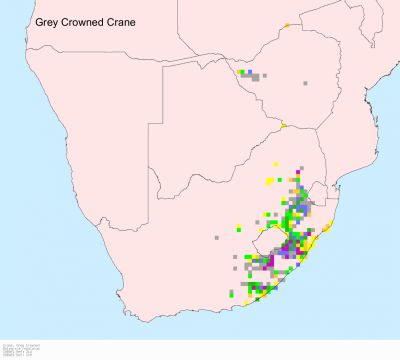
Habitat
Marshes, dams and adjoining grasslands.
Diet
It is omnivorous, feeding on a range of seeds, leaves as well as locusts, grasshoppers, worms and small vertebrates. It hunts animals by stamping its foot on the ground to disturb them, then plucking them up with its bill.
Breeding
Monogamous, territorial solitary nester, performing an amazing courtship display. Both sexes build the nest, which is a huge mound 1-2m wide. It is built with aquatic vegetation collected nearby the nest, and is typically placed in water. It may also build its nest on dry ground just above the water level or in trees. Egg-laying season is highly variable from area to area, although it usually peaks from November-January. It lays 2-4 dirty white eggs, which are incubated by both sexes for 29-31 days. The chicks leave the nest within hours of hatching, staying in the vicinity of the nest for at least two weeks. They learn to fly when they are 56-100 days old, only becoming independent at at least 120 days old.
Call
The Crowned Crane has a booming call which involves inflation of the red gular sac. It also makes a honking sound quite different from the trumpeting of other crane species. Duet by mated pair is series of low-pitched rhythmic booming, male lower pitched than female. Flight call bisyllabic mournful ma-hem. Listen to Bird Call.
Spoor

Status
Fairly common resident, but threatened. In 2012 it was uplisted from Vulnerable to Endangered by the IUCN.
Links:
EWT Factsheet
Order: Gruiformes. Family: Gruidae

Description
It is about 1 m tall and weighs 3 to 4 kg. It has a wingspan of between 180 and 200 cm. Plumage is distinctive, mainly grey. The wings are also predominantly white, but contain feathers with a range of colours. The head has a crown of stiff golden feathers. The sides of the face are white, and there is a bright red inflatable throat pouch. In flight, the only crane in the region to have white upper- and underwing coverts. The bill is relatively short and grey, and the legs are black. The sexes are similar, although males tend to be slightly larger.
Juveniles look browner, lack the white face patch, and the crown and wattles are less developed.
Taxonomy
There are two subspecies. The East African Balearica regolum gibbericeps occurs from eastern Democratic Republic of the Congo through Uganda and Kenya to eastern South Africa. It has a larger area of bare red facial skin above the white patch than the smaller Balearica regulorum regulorum which breeds from Angola south to South Africa.
Distribution
From Kenya and Uganda south to southern Africa, where it is uncommon to locally common in northern Namibia, north-eastern Botswana, Zimbabwe, central Mozambique and south-eastern South Africa.

Habitat
Marshes, dams and adjoining grasslands.
Diet
It is omnivorous, feeding on a range of seeds, leaves as well as locusts, grasshoppers, worms and small vertebrates. It hunts animals by stamping its foot on the ground to disturb them, then plucking them up with its bill.
Breeding
Monogamous, territorial solitary nester, performing an amazing courtship display. Both sexes build the nest, which is a huge mound 1-2m wide. It is built with aquatic vegetation collected nearby the nest, and is typically placed in water. It may also build its nest on dry ground just above the water level or in trees. Egg-laying season is highly variable from area to area, although it usually peaks from November-January. It lays 2-4 dirty white eggs, which are incubated by both sexes for 29-31 days. The chicks leave the nest within hours of hatching, staying in the vicinity of the nest for at least two weeks. They learn to fly when they are 56-100 days old, only becoming independent at at least 120 days old.
Call
The Crowned Crane has a booming call which involves inflation of the red gular sac. It also makes a honking sound quite different from the trumpeting of other crane species. Duet by mated pair is series of low-pitched rhythmic booming, male lower pitched than female. Flight call bisyllabic mournful ma-hem. Listen to Bird Call.
Spoor

Status
Fairly common resident, but threatened. In 2012 it was uplisted from Vulnerable to Endangered by the IUCN.
Links:
EWT Factsheet
- Flutterby
- Posts: 44029
- Joined: Sat May 19, 2012 12:28 pm
- Country: South Africa
- Location: Gauteng, South Africa
- Contact:
Grey Crowned Crane Photos
209. Grey Crowned Crane Balearica regulorum (Mahem)
 © Duke
© Duke
Lake Nakuru, Kenya
 © LBUS
© LBUS
Rare sighting of a Crowned Crane in Kruger National Park (May 2013)
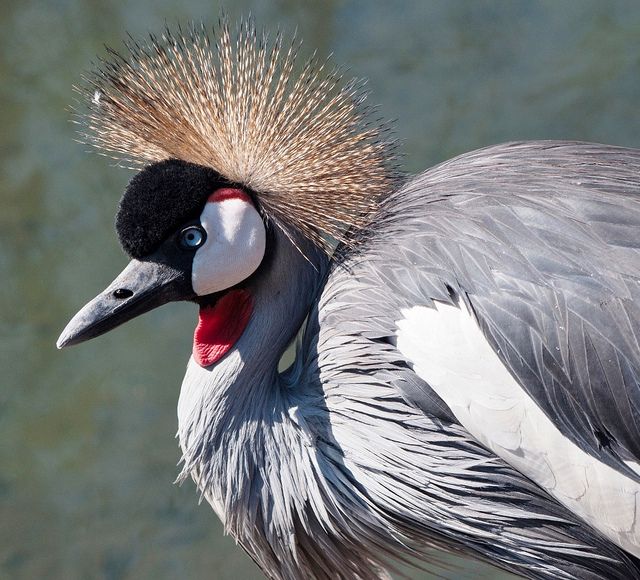 © steamtrainfan
© steamtrainfan
 © Kesheshe
© Kesheshe
Zambia, South Luangwa National Park
 © Michele Nel
© Michele Nel
Busanga Bush Camp, Kafue National Park, Zambia
Links
Species text in The Atlas of Southern African Birds
Sabap2
International Crane Foundation
Oiseaux net: http://www.oiseaux-birds.com/card-grey- ... crane.html
 © Duke
© DukeLake Nakuru, Kenya
 © LBUS
© LBUSRare sighting of a Crowned Crane in Kruger National Park (May 2013)
 © steamtrainfan
© steamtrainfan © Kesheshe
© KeshesheZambia, South Luangwa National Park
 © Michele Nel
© Michele NelBusanga Bush Camp, Kafue National Park, Zambia
Links
Species text in The Atlas of Southern African Birds
Sabap2
International Crane Foundation
Oiseaux net: http://www.oiseaux-birds.com/card-grey- ... crane.html
- Flutterby
- Posts: 44029
- Joined: Sat May 19, 2012 12:28 pm
- Country: South Africa
- Location: Gauteng, South Africa
- Contact:
Blue Crane
208. Blue Crane Grus paradisea (Bloukraanvoel)
Order: Gruiformes. Family: Gruidae
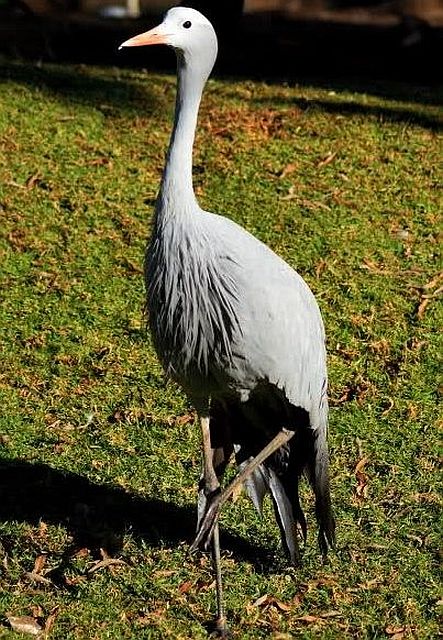
Description
Body plumage is silvery bluish grey becoming darker on the upper neck and the lower half of the head and nape. Blue Cranes have a long neck supporting a rather bulbous head, short pink bill and black legs. The primary feathers are black or slate grey. The tertial feathers (inner wing feathers) are long, dark and hang almost to the ground. Sexes are alike.
Juveniles are a paler grey and lack the trailing inner wing feathers, elongated tertials develop at about 1 year.
Distribution
It is endemic to southern Africa, with almost all of the population occurring in southern, central and eastern parts of South Africa. There are also small breeding populations in northern Namibia (comprising of about 35 to 40 birds in Etosha National Park) and western Swaziland. This crane occurs also in Lesotho, Zimbabwe and Botswana.
Habitat
It generally prefers open grassland, dwarf shrubland and cultivated land.
Movements and migrations
Largely resident, although in winter it moves from the cold, high-lying plateau of South Africa to the warmer savanna areas of Mpumalanga and adjacent provinces.
Diet
The Blue Crane is primarily vegetarian and eats small bulbs, seeds and roots. They do, however, eat a variety of insects (locusts, termites, caterpillars, grasshoppers, beetles, etc.), worms, crabs, fish, frogs, reptiles, and small mammals.
Breeding
Monogamous, territorial solitary nester. A pair of Blue Cranes is said to mate for life and display a wonderful courtship dance which comprises of the two individuals jumping up and down with their wings extended. The nest is either a pad of vegetation on wet ground, or a simple scrape in dry ground with a layer of pebbles, vegetation and mammal dung. Egg-laying season is from August-April, peaking from October-December. They usually lay two eggs with an incubation period of 29 to 33 days and both male and female incubate the eggs. The chicks leave the nest about 12 hours after hatching, at which the point the adults lead them away to teach them to forage. The siblings are extremely aggressive to each other at first, although lessening in intensity when they start to find food for themselves at about 15 days old. They take their first flight at about 12 weeks old, becoming fully independent approximately two months later.
Call
Loud, guttural, rattling kraaaarrrk, often in duet with male lower-pitched than female. Listen to Bird Call.
Status
Endemic resident. Some populations thought to be migratory, some locally nomadic and others largely resident. Out of breading season forms large flocks up to 1,000 birds. Roosts in shallow waters at night. Classified as Vulnerable (VU) by the IUCN Red List.
Order: Gruiformes. Family: Gruidae

Description
Body plumage is silvery bluish grey becoming darker on the upper neck and the lower half of the head and nape. Blue Cranes have a long neck supporting a rather bulbous head, short pink bill and black legs. The primary feathers are black or slate grey. The tertial feathers (inner wing feathers) are long, dark and hang almost to the ground. Sexes are alike.
Juveniles are a paler grey and lack the trailing inner wing feathers, elongated tertials develop at about 1 year.
Distribution
It is endemic to southern Africa, with almost all of the population occurring in southern, central and eastern parts of South Africa. There are also small breeding populations in northern Namibia (comprising of about 35 to 40 birds in Etosha National Park) and western Swaziland. This crane occurs also in Lesotho, Zimbabwe and Botswana.
Habitat
It generally prefers open grassland, dwarf shrubland and cultivated land.
Movements and migrations
Largely resident, although in winter it moves from the cold, high-lying plateau of South Africa to the warmer savanna areas of Mpumalanga and adjacent provinces.
Diet
The Blue Crane is primarily vegetarian and eats small bulbs, seeds and roots. They do, however, eat a variety of insects (locusts, termites, caterpillars, grasshoppers, beetles, etc.), worms, crabs, fish, frogs, reptiles, and small mammals.
Breeding
Monogamous, territorial solitary nester. A pair of Blue Cranes is said to mate for life and display a wonderful courtship dance which comprises of the two individuals jumping up and down with their wings extended. The nest is either a pad of vegetation on wet ground, or a simple scrape in dry ground with a layer of pebbles, vegetation and mammal dung. Egg-laying season is from August-April, peaking from October-December. They usually lay two eggs with an incubation period of 29 to 33 days and both male and female incubate the eggs. The chicks leave the nest about 12 hours after hatching, at which the point the adults lead them away to teach them to forage. The siblings are extremely aggressive to each other at first, although lessening in intensity when they start to find food for themselves at about 15 days old. They take their first flight at about 12 weeks old, becoming fully independent approximately two months later.
Call
Loud, guttural, rattling kraaaarrrk, often in duet with male lower-pitched than female. Listen to Bird Call.
Status
Endemic resident. Some populations thought to be migratory, some locally nomadic and others largely resident. Out of breading season forms large flocks up to 1,000 birds. Roosts in shallow waters at night. Classified as Vulnerable (VU) by the IUCN Red List.
- Flutterby
- Posts: 44029
- Joined: Sat May 19, 2012 12:28 pm
- Country: South Africa
- Location: Gauteng, South Africa
- Contact:
Blue Crane Photos
208. Blue Crane Grus paradisea
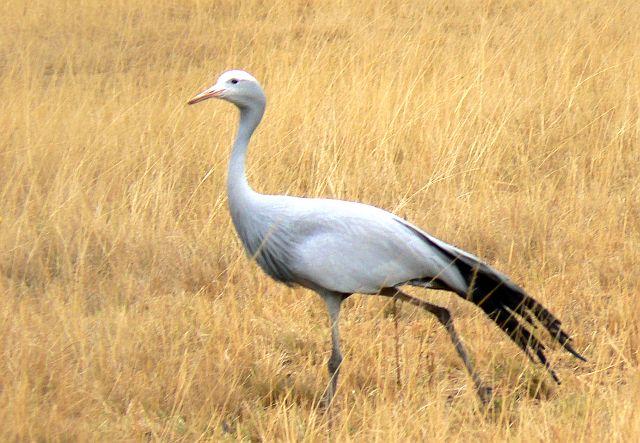 © Toko
© Toko
Swaziland
 © Kesheshe
© Kesheshe
Etosha National Park, Namibia
 © Michele Nel
© Michele Nel
Western Cape
The Blue Crane is the national bird of South Africa, yet it is threatened. It is endemic to Southern Africa. Of the 15 species of crane, the Blue Crane has the most restricted distribution of all.
Links:
Species text Sabap1
Sabap2
International Crane Foundation
ARKive: http://www.arkive.org/blue-crane/anthro ... aradiseus/
Oiseaux net: http://www.oiseaux-birds.com/card-blue-crane.html
 © Toko
© TokoSwaziland
 © Kesheshe
© KeshesheEtosha National Park, Namibia
 © Michele Nel
© Michele NelWestern Cape
The Blue Crane is the national bird of South Africa, yet it is threatened. It is endemic to Southern Africa. Of the 15 species of crane, the Blue Crane has the most restricted distribution of all.
Links:
Species text Sabap1
Sabap2
International Crane Foundation
ARKive: http://www.arkive.org/blue-crane/anthro ... aradiseus/
Oiseaux net: http://www.oiseaux-birds.com/card-blue-crane.html
- Flutterby
- Posts: 44029
- Joined: Sat May 19, 2012 12:28 pm
- Country: South Africa
- Location: Gauteng, South Africa
- Contact:
Wattled Crane
207. Wattled Crane Grus carunculatus (Lelkraanvoel)
Order: Gruiformes. Family: Gruidae
Description
172 cm. It is the largest crane in Africa with the back and wings ashy gray. The feathered portion of the head is dark slaty gray above the eyes and on the crown, but is otherwise white, including the wattles, which are almost fully feathered and hang down from under the upper throat. The breast, primaries, secondaries, and tail coverts are black. The secondaries are long and nearly reach the ground. The upper breast and neck are white all the way to the face. The skin in front of the eye extending to the base of the beak and tip of the wattles is red and bare of feathers and covered by small round wart-like bumps. Wattled Cranes have long bills and black legs and toes. Males and females are virtually indistinguishable although males tend to be slightly larger. Juveniles have tawny body plumage, lack the bare skin on the face, lack elongated tertials; naked facial skin and wattles reduced in size.
Distribution
Occurs in Ethiopia and from Zambia, southern DRC and Malawi to southern Africa. Here it is uncommon to rare in north-eastern Namibia (including the Caprivi Strip), northern Botswana, central Zimbabwe and Mozambique, Mpumalanga and KwaZulu-Natal.
Habitat
Shallow wetlands with emergent vegetation, upland vleis and freshwater marshes and adjoining grassland, sometimes moving to man-made dams and cultivated fields.
Diet
The Wattled Crane mainly eats aquatic vegetation, but also eats tubers, rhizomes, seeds, small reptiles, frogs and insects, doing most of foraging by touch, digging with the beak in moist soil or shallow water. It often submerges its entire head under water when feeding.
Breeding
Monogamous, solitary nester. The nest is built by both sexes, consisting of a mound of aquatic vegetation with a central cup surrounded by open water. Its size can reach up to 120-180cm in diameter. Egg-laying season is year-round, peaking from April-September. The female lays one or two eggs, but usually only one chick is reared. The incubation lasts about 33-36 days, shared by both parents. The chicks are precocial, leaving the nest soon after hatching. They return to the nest every night to roost until they are about 100 days old, taking their first flight at about 90-130 days old. They become fully independent roughly 7-12 months later.
Winter breeding attributed to reduced flood risk and increased tuber availability. Does not always breed annually.
Call
Their calls are high-pitched and include a far-carrying kwaamk bugle-call. Synchronised duet: deep kah-eee repeated a number of times.
Spoor

Status
Uncommon to rare resident. Some populations sedentary, especially those on permanent wetlands, others nomadic. Found singly, in pairs, or in flocks of up to 100 birds in the Okavango, Botswana. Globally Vulnerable, but Critically endangered in South Africa. The Wattled Crane is by far the most endangered crane species in South Africa with only 240 left. They are the most wetland-dependent of Africa's crane species and are exceptionally susceptible to disturbance while nesting in wetlands, and will easily desert a nest if disturbed.
Order: Gruiformes. Family: Gruidae
Description
172 cm. It is the largest crane in Africa with the back and wings ashy gray. The feathered portion of the head is dark slaty gray above the eyes and on the crown, but is otherwise white, including the wattles, which are almost fully feathered and hang down from under the upper throat. The breast, primaries, secondaries, and tail coverts are black. The secondaries are long and nearly reach the ground. The upper breast and neck are white all the way to the face. The skin in front of the eye extending to the base of the beak and tip of the wattles is red and bare of feathers and covered by small round wart-like bumps. Wattled Cranes have long bills and black legs and toes. Males and females are virtually indistinguishable although males tend to be slightly larger. Juveniles have tawny body plumage, lack the bare skin on the face, lack elongated tertials; naked facial skin and wattles reduced in size.
Distribution
Occurs in Ethiopia and from Zambia, southern DRC and Malawi to southern Africa. Here it is uncommon to rare in north-eastern Namibia (including the Caprivi Strip), northern Botswana, central Zimbabwe and Mozambique, Mpumalanga and KwaZulu-Natal.
Habitat
Shallow wetlands with emergent vegetation, upland vleis and freshwater marshes and adjoining grassland, sometimes moving to man-made dams and cultivated fields.
Diet
The Wattled Crane mainly eats aquatic vegetation, but also eats tubers, rhizomes, seeds, small reptiles, frogs and insects, doing most of foraging by touch, digging with the beak in moist soil or shallow water. It often submerges its entire head under water when feeding.
Breeding
Monogamous, solitary nester. The nest is built by both sexes, consisting of a mound of aquatic vegetation with a central cup surrounded by open water. Its size can reach up to 120-180cm in diameter. Egg-laying season is year-round, peaking from April-September. The female lays one or two eggs, but usually only one chick is reared. The incubation lasts about 33-36 days, shared by both parents. The chicks are precocial, leaving the nest soon after hatching. They return to the nest every night to roost until they are about 100 days old, taking their first flight at about 90-130 days old. They become fully independent roughly 7-12 months later.
Winter breeding attributed to reduced flood risk and increased tuber availability. Does not always breed annually.
Call
Their calls are high-pitched and include a far-carrying kwaamk bugle-call. Synchronised duet: deep kah-eee repeated a number of times.
Spoor

Status
Uncommon to rare resident. Some populations sedentary, especially those on permanent wetlands, others nomadic. Found singly, in pairs, or in flocks of up to 100 birds in the Okavango, Botswana. Globally Vulnerable, but Critically endangered in South Africa. The Wattled Crane is by far the most endangered crane species in South Africa with only 240 left. They are the most wetland-dependent of Africa's crane species and are exceptionally susceptible to disturbance while nesting in wetlands, and will easily desert a nest if disturbed.
- Flutterby
- Posts: 44029
- Joined: Sat May 19, 2012 12:28 pm
- Country: South Africa
- Location: Gauteng, South Africa
- Contact:
Wattled Crane Photos
207. Wattled Crane Grus carunculatus
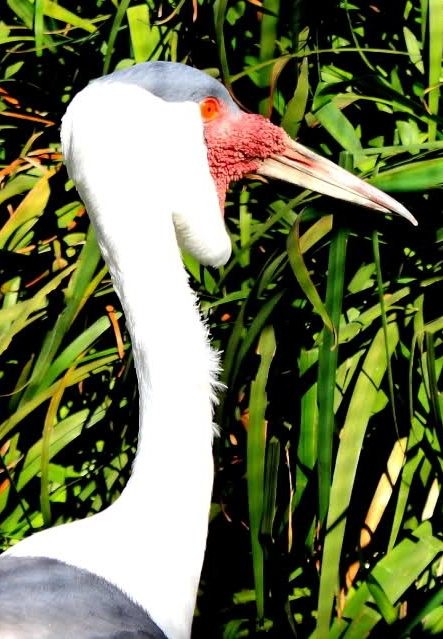 © Flutterby
© Flutterby
 © nan
© nan
Botswana
Links:
http://sabap2.adu.org.za/docs/sabap1/207.pdf
http://sabap2.adu.org.za/spp_summary.ph ... §ion=3
International Crane Foundation
Oiseaux net
 © Flutterby
© Flutterby © nan
© nanBotswana
Links:
http://sabap2.adu.org.za/docs/sabap1/207.pdf
http://sabap2.adu.org.za/spp_summary.ph ... §ion=3
International Crane Foundation
Oiseaux net
ORDER CHARADRIIFORMES
Charadriiformes is a diverse order of small to medium-large birds. It includes sandpipers, plovers, avocets, gulls, terns, auks, skuas, oystercatchers jacanas and phalaropes. Shorebirds, as their name implies, live along shores and coastlines. They also inhabit a variety of marine and freshwater wetlands and some members of the group—the gulls, for instance—have expanded their range to include dry inland habitats.
Most shorebirds exhibit strong flight abilities. Some species of shorebirds undertake the longest and most spectacular migrations of all birds. Arctic terns, for example, fly round-trip each year from the waters of the Antarctic where they spend the winter months to the Arctic where they breed. Other species spend long periods of time at sea. Young sooty terns, for example, leave their natal colonies and head ot to sea, where they remain for the first several years of their life before returning to land to breed for the first time.
Most shorebirds breed in large colonies and construct their nests on the ground using little nesting material or by simply scraping out a nest patch in the ground. Some shorebirds build their nests in roc crevices or ground burrows. A small number build their nests in trees. Most shorebirds lay just two to four eggs each breeding season and the eggs are often cryptically colored or patterened.
Shorebirds generally have a plummage that consists of white, gray, brown or black feathers. Many species have bright read or yellow feet. Some species also have bright red, orange or yellow bills, eyes, wattles or mouth linings.
Shorebirds feed on a variety of prey including marine worms, crustaceans and earthworms. Their feeding habits are likewise rather varied. Plovers, for example, forage by running across open ground and pecking at prey they come across. Sandpipers use their long bills to probe the mud for invertebrates. woodcock also probe for their prey but do so in their woodland habitat. Avocets and stilts swish their bills back and forth in shallow water to capture prey.
Shorebirds inhabit beaches, rocky coasts, estuaries, river banks, lakeshores and a variety of other marine and freshwater wetlands. Some species inhabit dry inland habitats while others are pelagic, spending most of their time flying over open oceans.
Shorebirds are, as a group, worldwide in distribution.
ORDER CHARADRIIFORMES
Family Turnicidae (Buttonquail)
Family Burhinidae (Thick-knees)
Family Chionidae (Sheathbill)
Family Haematopodidae (Oystercatchers)
Family Dromadidae (Crab Plover)
Family Recurvirostridae (Stilts, Avocets)
Family Charadriidae (Plovers)
Family Rostratulidae (Painted Snipe)
Family Jacanidae (Jacanas)
Family Scolopacidae (Sandpipers, Snipes)
Family Glareolidae (Coursers, Pratincoles)
Family Laridae (Gulls, Terns and Skimmers)
Family Stercorariidae (Skuas)
Most shorebirds exhibit strong flight abilities. Some species of shorebirds undertake the longest and most spectacular migrations of all birds. Arctic terns, for example, fly round-trip each year from the waters of the Antarctic where they spend the winter months to the Arctic where they breed. Other species spend long periods of time at sea. Young sooty terns, for example, leave their natal colonies and head ot to sea, where they remain for the first several years of their life before returning to land to breed for the first time.
Most shorebirds breed in large colonies and construct their nests on the ground using little nesting material or by simply scraping out a nest patch in the ground. Some shorebirds build their nests in roc crevices or ground burrows. A small number build their nests in trees. Most shorebirds lay just two to four eggs each breeding season and the eggs are often cryptically colored or patterened.
Shorebirds generally have a plummage that consists of white, gray, brown or black feathers. Many species have bright read or yellow feet. Some species also have bright red, orange or yellow bills, eyes, wattles or mouth linings.
Shorebirds feed on a variety of prey including marine worms, crustaceans and earthworms. Their feeding habits are likewise rather varied. Plovers, for example, forage by running across open ground and pecking at prey they come across. Sandpipers use their long bills to probe the mud for invertebrates. woodcock also probe for their prey but do so in their woodland habitat. Avocets and stilts swish their bills back and forth in shallow water to capture prey.
Shorebirds inhabit beaches, rocky coasts, estuaries, river banks, lakeshores and a variety of other marine and freshwater wetlands. Some species inhabit dry inland habitats while others are pelagic, spending most of their time flying over open oceans.
Shorebirds are, as a group, worldwide in distribution.
ORDER CHARADRIIFORMES
Family Turnicidae (Buttonquail)
Family Burhinidae (Thick-knees)
Family Chionidae (Sheathbill)
Family Haematopodidae (Oystercatchers)
Family Dromadidae (Crab Plover)
Family Recurvirostridae (Stilts, Avocets)
Family Charadriidae (Plovers)
Family Rostratulidae (Painted Snipe)
Family Jacanidae (Jacanas)
Family Scolopacidae (Sandpipers, Snipes)
Family Glareolidae (Coursers, Pratincoles)
Family Laridae (Gulls, Terns and Skimmers)
Family Stercorariidae (Skuas)
Family Turnicidae Buttonquail
Family Turnicidae (Buttonquail)
Buttonquail or hemipodes are members of a small family of birds, Turnicidae, which resemble, but are unrelated to, the quails of Phasianidae. They inhabit warm grasslands in Asia, Africa, Europe, and Australia. There are 16 species in two genera, with most species being found in the genus Turnix and only one being found in the genus Ortyxelos.
Buttonquails are small, drab, running birds, which avoid flying. The buttonquails in the genus Turnix range from 12–23 cm in length and weigh between 30–130 g. They superficially resemble the true quails of the genus Coturnix, but differ from them in lacking a hind toe and a crop. The females of this family also possess a unique vocal organ created by an enlarged trachea and inflatable bulb in the oesophagus, which they use to produce a booming call.The female is the more brightly coloured of the sexes, and initiates courtship. Unusually, the buttonquails are polyandrous, with the females circulating among several males and expelling rival females from her territory. Both sexes cooperate in building a nest in the earth, but only the male incubates the eggs and tends the young. The eggs hatch after an incubation period of 12 or 13 days, and the young are able to fly within two weeks of hatching.
Species indigenous to southern Africa:
Turnix sylvaticus Common Buttonquail 205
Turnix hottentottus Fynbos Buttonquail 206.1
Turnix nanus Black-rumped Buttonquail 206
Links: Trevor Carnaby: Beat about the Bush: Birds - Buttonquails
Buttonquail or hemipodes are members of a small family of birds, Turnicidae, which resemble, but are unrelated to, the quails of Phasianidae. They inhabit warm grasslands in Asia, Africa, Europe, and Australia. There are 16 species in two genera, with most species being found in the genus Turnix and only one being found in the genus Ortyxelos.
Buttonquails are small, drab, running birds, which avoid flying. The buttonquails in the genus Turnix range from 12–23 cm in length and weigh between 30–130 g. They superficially resemble the true quails of the genus Coturnix, but differ from them in lacking a hind toe and a crop. The females of this family also possess a unique vocal organ created by an enlarged trachea and inflatable bulb in the oesophagus, which they use to produce a booming call.The female is the more brightly coloured of the sexes, and initiates courtship. Unusually, the buttonquails are polyandrous, with the females circulating among several males and expelling rival females from her territory. Both sexes cooperate in building a nest in the earth, but only the male incubates the eggs and tends the young. The eggs hatch after an incubation period of 12 or 13 days, and the young are able to fly within two weeks of hatching.
Species indigenous to southern Africa:
Turnix sylvaticus Common Buttonquail 205
Turnix hottentottus Fynbos Buttonquail 206.1
Turnix nanus Black-rumped Buttonquail 206
Links: Trevor Carnaby: Beat about the Bush: Birds - Buttonquails


